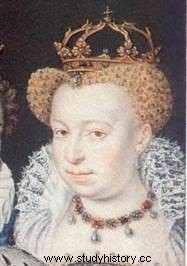 Daisy of Valois (1553-1615), known as Queen Margot , Queen of France and Navarre, was the daughter of King Henry II and Catherine de Medici and the sister of Charles IX and Henry III. In 1572, she married the leader of the Huguenots, Henri de Navarre (future Henri IV), symbolizing an attempt at reconciliation between Protestants and Catholics. Immortalized in the cinema by actress Isabelle Adjani, Queen Margot was not the “saucy girl” that the novelists described to us. Too often used as a "pawn" by her mother in the midst of religious wars of the 16th century, she received many funeral tributes on her death in 1615:"the Queen of greatness, the greatness of spirits, the noble of flowers, the Marguerite of France .
Daisy of Valois (1553-1615), known as Queen Margot , Queen of France and Navarre, was the daughter of King Henry II and Catherine de Medici and the sister of Charles IX and Henry III. In 1572, she married the leader of the Huguenots, Henri de Navarre (future Henri IV), symbolizing an attempt at reconciliation between Protestants and Catholics. Immortalized in the cinema by actress Isabelle Adjani, Queen Margot was not the “saucy girl” that the novelists described to us. Too often used as a "pawn" by her mother in the midst of religious wars of the 16th century, she received many funeral tributes on her death in 1615:"the Queen of greatness, the greatness of spirits, the noble of flowers, the Marguerite of France .
The youth of Marguerite de Valois
Marguerite de Valois was born in May 1553 at the Château de Saint Germain, weak and thin. Of her five brothers and two sisters, the future Charles IX nicknamed her Margot. Speaking early, she received a princess education in Amboise:literature, dance and music. Raised in fear of her mother, she was only six years old when her father Henry II died, but with her temperament, she resisted and refused to change her religion.
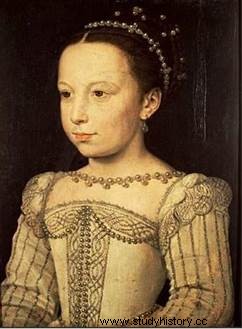 We talk to him about alliances… Jeanne d'Albret wishes Marguerite for her son, the king of Portugal for his young Sebastian, the King of Spain for Don Carlos, Philip II of Spain for himself after Elisabeth's death… little Marguerite is playing with Henri de Guise! Falling in love with him, she is watched and denounced, despite the existing friendship with her brother Henri d'Anjou, to whom she serves as a "spy". Henri de Guise declares his love for him, a plot is mounted against him, he leaves the Court and sees himself married to Catherine de Cleves.
We talk to him about alliances… Jeanne d'Albret wishes Marguerite for her son, the king of Portugal for his young Sebastian, the King of Spain for Don Carlos, Philip II of Spain for himself after Elisabeth's death… little Marguerite is playing with Henri de Guise! Falling in love with him, she is watched and denounced, despite the existing friendship with her brother Henri d'Anjou, to whom she serves as a "spy". Henri de Guise declares his love for him, a plot is mounted against him, he leaves the Court and sees himself married to Catherine de Cleves.
Marriage for reasons of state
The steps in favor of the Prince of Navarre resumed in August 1571, but Jeanne d'Albret "dragged her feet"... For her, the court of France was only make-up, various corruptions and looks like Hell. Eventually, she meets Charles IX and Catherine de Medici, who coax her (the king wants revenge on his enemies, so he grants his sister's hand to a Huguenot). The contract was signed on April 11, 1572, despite the absence of letters of dispensation from the pope and the sudden death of Jeanne d'Albret in June. On July 20, the King of Navarre and future Henri IV arrives in Paris, with 800 gentlemen, the marriage is celebrated in August 1572.
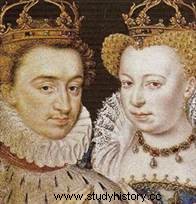 More than 120 ladies flaunt their finery of gold and silver velvet. The 2 “separate” processions are surprising:on one side the king, the queen mother, the princes of the blood, the house of Lorraine; on the other, the King of Navarre, the Prince of Condé, Admiral de Coligny, the Count of La Rochefoucauld… While Marguerite is listening to mass, the King of Navarre and his friends stroll through the cloister. We pick him up at the end of mass for the “Yes”. Marguerite is silent, not forgetting the love of Guise and Charles IX, very angry, pushes her head forward:it will be the "Yes". The meal and the festivities last 3 days, with delicious dishes and pompous shows.
More than 120 ladies flaunt their finery of gold and silver velvet. The 2 “separate” processions are surprising:on one side the king, the queen mother, the princes of the blood, the house of Lorraine; on the other, the King of Navarre, the Prince of Condé, Admiral de Coligny, the Count of La Rochefoucauld… While Marguerite is listening to mass, the King of Navarre and his friends stroll through the cloister. We pick him up at the end of mass for the “Yes”. Marguerite is silent, not forgetting the love of Guise and Charles IX, very angry, pushes her head forward:it will be the "Yes". The meal and the festivities last 3 days, with delicious dishes and pompous shows.
Only the people do not appreciate, marriage with Protestants is an insult. The latter prefer to leave the place, Coligny is attacked, La Rochefoucauld is killed!
The role of Queen Margot
After the massacres of Saint Barthélemy, Marguerite pleads the cause of her husband, an ally of François d'Alençon. Already abandoned by Navarre, they live in perfect harmony. For the reception of the Polish embassy, she holds her rank perfectly, makes an applauded speech "that everyone called her a second Minerva or goddess of eloquence" and triumphs during the festivities. As a good girl from France, she stops the attempt to escape from her brother from Alençon and her husband; a year later, she defeated the political conspiracy set up by Montmorency, Turenne and Cossé, becoming the mistress of Joseph de Boniface, lord of La Mole (belonging to d'Alençon).
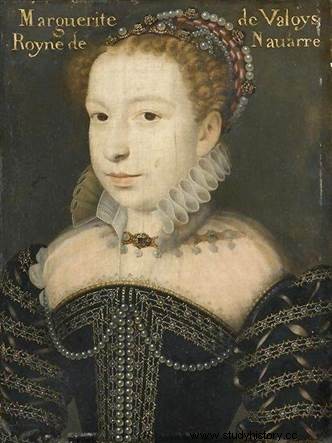 But after the death of Charles IX, Marguerite's position became difficult. Without her knowing it, her brother was protecting her. When her husband and d'Alençon are in prison in Vincennes, as a good wife, she thinks of helping them escape...but as they are arguing about who should get out first, she gives up.
But after the death of Charles IX, Marguerite's position became difficult. Without her knowing it, her brother was protecting her. When her husband and d'Alençon are in prison in Vincennes, as a good wife, she thinks of helping them escape...but as they are arguing about who should get out first, she gives up.
She keeps her role during the festivities in Lyon, despite the gossip about her affair with Bussy d'Amboise. Navarre expels his only confidante Madame de Thorigny:there, the tension between the spouses is at its peak. Alençon left the court in September, Henri de Navarre slipped away in February 1576…and Marguerite was placed under arrest in her room and forbidden to leave the kingdom. They turned their backs on him, despite the protests of Alençon, Crillon and even Navarre, who sent an emissary to the king. Attempting to take the waters at Spa, his escape is unmasked; she joined Alençon to await peace there until September 1577.
Thanks to d'Alençon who fled from the Louvre in February 1578 and who formed an army to go to Flanders (Flanders are Spanish!), the queen mother let her girl but will be on the trip, with her Flying Squadron, to check the Reformed troops. On August 2, Marguerite sets off with the whole house that Henry III has deigned to set up for her.
At the Court of Nérac
In Bordeaux, Marguerite is welcomed with open arms, having to serve as a reconciler between her husband and Marshal de Biron. In Nérac, she is happy to find her rank, her castle, her husband and we rub shoulders pleasantly. She is courted by the Viscount of Turenne, while Henri takes care of La Rebours (Marguerite's maid of honor) and decides to manage her husband's mistresses by establishing the theory of Neoplatonic love! “We lily of the valley, we flirt, but it is forbidden to deflower! ". Everything works until Navarre learns of the relationship between Turenne and Marguerite. Not letting it go, the "lovers' war" was declared at the end of 1579:it was a question of taking the towns belonging to one or the other, but without either of them no one else knows:this is the case for Cahors!
There is talk of a breakup, even though Marguerite is present during the king's 17 days of illness and when she helps Belle Fosseuse (the king's mistress) give birth to a daughter stillborn.
Marguerite is bored in this Court which is not comparable to that of the Louvre, despite the conspiracies and rumors, until the arrival of Jacques du Harlay, seigneur de Champvallon, friend of Alençon. Of great beauty, educated, he has everything to please, he speaks to her of love, she quickly forgets Bussy, ousts Pibrac, loves Champvallon, whom she finds in Paris at the beginning of 1582 when Henri III calls her back to put an end to the rebellion . The whole Louvre is aware of the child of Navarre and the Belle Fosseuse:she is fired. Navarre is furious, Marguerite remonstrates with him, helped for once by her mother.
Too beautiful and too intelligent, Henri III could no longer stand his sister and chased her away at a ball on August 7, 1583. Without money, without support, she left for Nérac, but Cognac Navarre stops it, too busy with Corisande until April 1584 when he agrees to take it back. The reception is cold, she is put aside and humiliated. As queen, however, she receives from Epernon who must convert the king to Catholicism. But Navarre makes life difficult for him:he has his secretary kidnapped, threatens him with torture, yet he is only courier between Catherine de Medici and her daughter.
In March 1585, feeling unsafe, Marguerite went to Agen for her devotions, locked herself in the castle, created almost an entire army at her command. The civil war is launched. She asks Henri de Guise for help in repelling the heretics. Unfortunately the Maréchal de Matignon retakes Agen and scares Marguerite away.
Marguerite Reine d’Usson
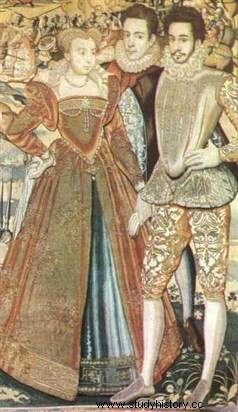 With only part of her escort left, she heads towards Carlat, who is hostile to her. Harassed from all sides, she tries to raise troops in Gascony. Abandoned by Henri III and by Henri de Navarre, she turned to her mother who offered her asylum in the castle at Ybois, near Issoire, in the autumn of 1586. But it was a plot:Canillac, obeying the king , seizes Marguerite, makes her prisoner in the castle of Usson. Rumors are already running “the Queen of Navarre is very ill. She feels the general pains and is in such a state that one can only expect a sad result. Marguerite understands that the Valois have removed her from their family! She writes to her mother to take care of her guards and ladies-in-waiting, in order to pay them and put them back, if she should ever disappear. At the end of the year, his mother and his brother calm down and force Navarre to take care of his wife.
With only part of her escort left, she heads towards Carlat, who is hostile to her. Harassed from all sides, she tries to raise troops in Gascony. Abandoned by Henri III and by Henri de Navarre, she turned to her mother who offered her asylum in the castle at Ybois, near Issoire, in the autumn of 1586. But it was a plot:Canillac, obeying the king , seizes Marguerite, makes her prisoner in the castle of Usson. Rumors are already running “the Queen of Navarre is very ill. She feels the general pains and is in such a state that one can only expect a sad result. Marguerite understands that the Valois have removed her from their family! She writes to her mother to take care of her guards and ladies-in-waiting, in order to pay them and put them back, if she should ever disappear. At the end of the year, his mother and his brother calm down and force Navarre to take care of his wife.
Reassured about her life, Marguerite thinks only of revenge. Master in her castle, she organizes the resistance to the royal power, Usson having become the headquarters of the league leaders. She began writing her Memoirs, which she dedicated to Brantôme and met Saint Vidal (head of Velay), the Count of Randan (commander of Auvergne), Urfé (the famous author of Astrée).
The shock of her brother's death brings her closer to her husband. Pushed by Gabrielle d'Estrées, Navarre asks her to annul their marriage. Marguerite consents to this, if she keeps all the advantages acquired as well as money to pay her debts. The negotiations last more than 5 years. In exchange for her help during the trial against Henriette d'Entragues, she asks for her share of the inheritance and dedicates it to the Dauphin Louis. Gabrielle disappearing, Marguerite appeared on October 21, 1599, ready to do anything to facilitate and accelerate the dissolution of the marriage, having only one goal:to leave Usson.
Everything goes very quickly:on November 10 the marriage is declared void, she retains her title of Queen and Duchess of Valois, her domains and receives 200,000 écus payable in 4 years . Henri IV and Marie de Médicis married in December 1600 and on September 27, 1601, Louis XIII was born.
Queen Margot's return to Paris
Finally, having received permission to return, on July 18, 1605, she crossed Paris escorted by the little Duke of Vendôme. On the 26th, Henri IV visited him at the castle of Madrid and the next day, it was Marie de Médicis. Marguerite is welcomed at the Louvre and applauded by the people. On August 6, the Dauphin awaits him on the road to Saint Germain. In love with this little boy, Marguerite bequeaths all her possessions to him and offers him a Cupid studded with diamonds, seated on a dolphin with an emerald and a small scimitar studded with stones.
Often afflicted with malaise and dysentery, she has lost her beauty, is horribly fat, dresses like an old woman, her hair is fluffy blond hair (borrowed from valets for make wigs). In April 1606, she lost her young and dear squire Dat de Saint Julien whom she loved passionately and moved to Pré aux Clercs, the plague arriving in Paris. In September, she bought the house of Jean de la Haye, goldsmith to the king, in Issy, and began to embellish it, doing work in the park with statues and frescoes on the walls. She regularly welcomes the Dauphin, who in 1609 receives a cord of precious stones worth 3000 écus.
Back in Paris in October, she finds with great pleasure her squire Bajaumont, who has become a philosopher and a valiant soldier, whom she will lose at the end of 1609, attacked in the middle of the church. Its salons are filled with diplomats, soldiers, poets, it organizes receptions welcoming the king and queen, everything is discussed there, everything is done there:Henri IV himself says he is coming back from "Bordeaux". At the death of the king, she sings a solemn service and 2 funeral orations. Remaining on good terms with the queen, she played a role in the Franco-English alliance for Henriette's marriage, but lived apart from the court.
End of life of Marguerite de Valois
Towards the end of 1614, she fell ill with engorgement of the liver, complicated by gravel. His chaplain, judging the condition very serious, informed him. On March 7, 1615, she had the first stone of the tomb laid. She died on March 28, 1615 at the age of 62, leaving 100,000 pounds to the poor, 200,000 crowns of debts settled by Marie de Medici. A year later, her body was transported from the convent of the Daughters of the Sacred Heart to Saint Denis.
We cannot forget the end of the funeral speech of 1615:"Dead, Marguerite of France! Farewell to the delights of France, the paradise of court pleasures! The brilliance of our days, the day of beauties, the beauty of virtues, the cuteness of lilies, the lily of the princesses, the princess of the great, the queen of greatness, the greatness of spirits, the spirit of wisdom, the prudence of nobles, the noble of flowers, the flower of the Marguerites, the Marguerite of France”. Quite different from what the black legend of the queen will leave behind for posterity.
Bibliography
- Marguerite de Valois:Queen Margot – Eliane Viennot. Tempus 2005.
- Memoirs of Marguerite de Valois - Queen Margot. Mercury of France, 2004.
- Queen Margot, by Alexandre Dumas. Pocket 2012.
To go further
- Queen Margot, film by Patrice Chéreau.
